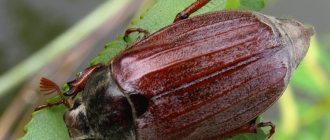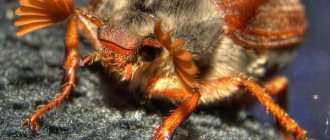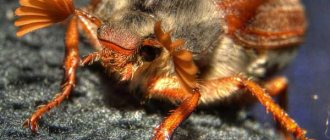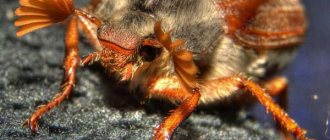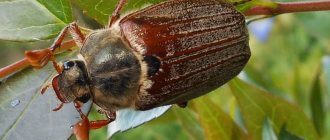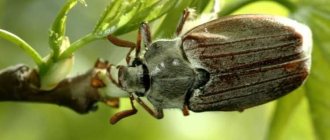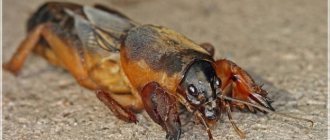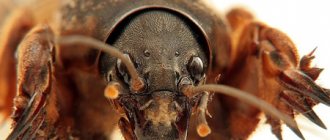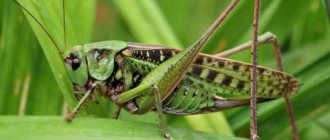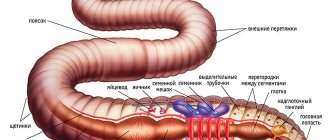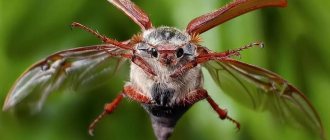Almost every person living in central Russia or in its European part has at least once encountered such a phenomenon as an invasion of cockchafers. Usually for children this event is of an entertaining nature. Large and loudly buzzing insects tend to fly around street lamps at dusk. Knocking on the glass and getting burned, they fall down and fall into the hands of young naturalists. But few people have thought about what cockchafers eat.
Important!
In addition to being fun for children, these insects are pests of tree crowns. Sometimes their invasion leaves behind serious and irreparable consequences. Trees lose part of their crown, causing photosynthesis processes to be disrupted and the plant cannot receive adequate nutrition. This factor leads to a decrease in yield or even the death of a flora representative.
Life cycle
The full life cycle of the cockchafer takes from 3 to 5 years, depending on the climate. For almost all five years, the cockchafer lives underground. The cockchafer flies for a relatively short time, only 30-40 days.
Reproduction
1-3 weeks after emerging from the pupa, the female cockchafer is ready to reproduce. After mating, she soon lays eggs, burrowing into the ground to a depth of about 10 cm. She then feeds, searches for a male and lays eggs again. The total number of eggs is about 70 pieces. The female performs such cycles up to four times, spending a lot of energy. After the last ovipositor, the female dies right in the soil.
Egg
The egg is off-white, 2 mm wide and 3 mm long. It is soft at first and hardens later. The egg develops within 24-35 days. Under unfavorable conditions, development can take up to 50 days.
Larva
The larva of the cockchafer is thick, light-colored, curved. The head is round and light yellow or brown in color. Equipped with 3 pairs of small tenacious paws. The last instar larva reaches a length of 45-65 mm.
Doll
The cockchafer pupa is located in the ground at a shallow depth, in a cradle. The shape resembles an adult beetle with short wings and a head tucked under the chest, the color is yellowish. Its length is 25 mm, width is 18 mm. The pupal phase lasts from 2 weeks to a month. The pupa appears in late July - early August at a depth of 20-40 cm.
Stages of development
- During the first summer, the larva feeds on humus and grass roots. In winter, the larvae climb to a depth of one and a half meters, and in the spring they move again closer to the roots.
- In the second year, the larvae feed on the roots of young trees.
- In the third year, the larvae reach a size of 5-6 centimeters and are able to gnaw the root of even an adult tree.
- In the fourth year of life, the larva turns into a pupa, and after a month or two - into a beetle.
The beetles hatched at the end of the season go into suspended animation and remain in the cradle until spring. And closer to May, when it gets warm and leaves appear on the trees, May beetles begin their flights.
Appearance
When the first greenery appears on the trees, various garden pests also appear. It is during this period, having safely overwintered in the ground, that the female May beetle or beetle begins to lay eggs. She lays them very deep - almost a meter deep, which makes it impossible to detect the masonry. Immediately after this, the females die, and after 20 days, larvae begin to hatch from a large number of eggs (on average 100 pieces). At a young age they are almost harmless, but as they mature they become formidable pests for garden and vegetable crops.
On a note!
Externally, the cockchafer larva looks like a thick white-yellow caterpillar with spots and rings on its sides. They are no larger in size than small worms, but already in the 2nd year they are 5 cm long, and then grow to 6.5-7 cm.
Their characteristic feature is a ring-shaped C-shape, but as they develop they increase in size, and a brown head becomes noticeable, on which there are no eyes (they are not needed underground). They have 3 pairs of legs covered with hair and a gnawing mouth with brown jaws, as seen in the photo of the cockchafer larva.
Reproduction and development of the May beetle (Khrushchev). Life cycle.
The chafer is characterized by development with complete transformation. The life cycle lasts from 3 to 5 years and consists of the following phases:
- The egg stage lasts 30-40 days,
- The pupal stage lasts 30-60 days,
- Beetles remain in the larval stage for about 3, less often 4 years.
- In the imago (adult) stage, the cockchafer lives for about a year.
The breeding season of cockchafers occurs at the end of May - beginning of June. After mating, the female burrows into the ground and lays 20-30 eggs. Then she feeds intensively again, mates, digs up the soil and makes another clutch. Each female lays eggs 3-4 times, after which she dies. The total number of eggs is 50-60, less often 70 pieces. The depth of the clutch reaches 20-30 cm. The eggs of the cockchafer are gray-white in color, with a diameter of 1.5 to 2.5 mm.
Photo credit: Erika Arias Cordero/MPI chem. Okol
After 30-40 days, the cockchafer larvae hatch from the eggs. The larvae, or furrowworms, have a thick, curved, white body with three pairs of limbs and a large, rounded yellow or brick-colored head. On the head of the larva there are strong and strong mandibles (the upper jaws of the oral apparatus). The body of the cockchafer larvae is covered with sparse hairs. Over the next 3 years, the May beetle larva develops and overwinters in the ground. For wintering, it burrows into the ground to a depth of approximately 1-1.5 meters, and in the spring, around April, it rises higher, into the upper layers of the soil. The first year of its life it feeds on humus and tender roots of herbs, and in the second summer it begins to eat thicker plant roots. During feeding, the larva can crawl up to 30 cm in a day. In autumn (around October), the larva of the cockchafer again migrates to the lower layers of the soil for the next wintering.
Photo by: Hedwig Storch
In the southern regions, after the third winter (in the northern after the fourth), in mid-summer, around the end of July - beginning of August, pupation occurs. The cockchafer larva, by this time 45-65 mm long, burrows deeper into the ground and turns into a pupa. The cockchafer pupa resides in a special chamber, the pupal cradle, and in appearance is already very similar to an adult. And yet, unlike the imago, it has a yellowish color, short and poorly developed wings, and a head turned down. The pupa measures 25 mm in length and about 18 mm in width. The pupal phase lasts 30-45 days. Then, still underground, the cockchafer emerges from the pupa and remains in the cradle.
The insect spends its last winter in the soil. May beetles fly out of the soil at the end of April (eastern) - early May (western): they dig a tunnel in the ground and get out. Eastern chafers fly out of their underground shelter 10-15 days earlier than western ones. Females emerge from the dungeon 7-10 days later than males. During this period, beetles are intensively searching for food, eating leaves, buds, shoots of trees and bushes, thereby causing significant damage to forests and agricultural plantings.
Photo by: Sanja565658
Lifespan
The development of the cockchafer is long, but its full existence is short. The total life cycle reaches 5 years, of which only one is summer (about 2 months), the beetles are active.
Let's take a closer look at the life stages of a beetle:
- 30 - 40 days - egg stage;
- 3 − 4 years - larval stage;
- 1.5 − 2 months. - pupal stage;
- imago (full-fledged beetle) - about a year, of which the insect is awake for only 5 - 7 weeks.
During this entire cycle, the family living in the roots of the plant can completely destroy the adult tree. Therefore, people actively use chemicals to combat Khrushchev.
Popular message topics
- City of Prokopyevsk
Prokopyevsk is one of the oldest cities in the Kemerovo region. It is home to about 196,000 thousand people, and it can also be added that the city was the center of coal mining in the country, and had as many as 16 coal mines, - Cell structure and division
A cell is an elementary part of an organism that can itself exist, self-reproduce and develop. It is a fundamental element of all living things, both organisms and plants. Cells can be independent organisms. - Gladiolus
It is impossible to imagine the world famous school holiday Day of Knowledge without bouquets of flowers. Many of them look spectacular thanks to the gladioli they contain. Translated from Latin, this word means sword.
Fighting the cockchafer
It has been noticed that in populations there are years with a predominant summer, that is, when a massive flight of the cockchafer occurs. Black beetles develop on a five-year cycle, and red beetles develop on a four-year cycle, so there are three or four-year breaks when chafer beetles are practically not found. Harm to agriculture and forestry is caused by both adults and larvae.
How to deal with the cockchafer?
For many years, scientists have been and are developing methods to reduce the number of cockchafers. So in the 50-60s, E. Khober and in the 70s, Ya. P. Tsinovsky and his group sterilized male May beetles with ionizing radiation and released them into nature.
This method made it possible to achieve a sharp reduction (75-100%) in the population size, which contributed to plant protection. But the method has not become widespread due to the need to collect a large number of males at the required time for irradiation.
Fighting cockchafer larvae
Modern summer residents recommend manually collecting and killing adult beetles from plants or destroying the larvae while digging up the soil.
Why are they dangerous?
Both the beetles themselves and their larvae can cause damage to your dacha. The beetle larva lives in the soil for about 4 years, after which at the end of summer or autumn it turns into a beetle. After wintering in the soil, the beetle emerges on the first warm days, which is what we observe in late spring.
So, for the first couple of years the larva is not particularly dangerous, since its diet is limited. Yes, it eats up the roots of various herbs and humus, but it does not do this particularly intensively.
The real problems begin when she reaches two years of age. At this time, the future beetle begins to actively feed, destroying the roots of cultivated plants: vegetables, flowers and seedlings. They eat potato tubers and even damage tree roots. The most intensive feeding begins before the larva transforms into a beetle, that is, in the fourth year of its life.
The beetle itself is also not as cute as it seems. It feeds on young green foliage of both trees and bushy plants. If there is only one insect, this is a victory, but if there are many of them, they can severely damage the foliage, which will slow down the development of the plant or lead to its death.
Thus, both states of a given insect are a threat to the dacha, and not just the larval stage, as some people think.
Now, let's look at how to get rid of this problem.
Description of the pest
May Khrushchev
- red with red legs and dorsum (rex), lives in the northern regions, and prefers to live in open areas, without shade,
- black with black legs and foreback (nigripes), which lives in the southern area in shaded places.
What do adults eat?
These insects appear with the simultaneous establishment of constant warm weather - at the end of April and in May. And it’s no secret that during this period the cockchafer eats all the young ovaries, flowers and leaves of forests, parks and fruit and berry trees.
Those who suffer most from it are:
- from parklands: birches, maples, lindens, willows, poplars and oaks,
- garden trees: apple trees, plum trees, apricots, cherries, peaches, pears,
- forest plantations: spruce and pine.
What do larvae eat?
What causes the most damage is:
- tuberous vegetable and ornamental plants, such as beets, carrots, potatoes, dahlias, etc.,
- roots of wild strawberries, strawberries, all types of black and red currants,
- the root system of apple and cherry trees, under which they can be found most often,
- forest and park plantings, especially young ones with delicate roots.
Description and features
Since ancient times, people have called these beetles Khrushchev. At times there were so many of them that they fell in abundance directly to the ground and fell under the feet of passers-by. People stepped on them, and a loud crunching sound was heard.
There is another version about the reasons for this nickname: supposedly these creatures are so voracious that they crunch themselves, eating young foliage with appetite, although few people have heard this with their own ears.
Later, scientists, having isolated these biological organisms into a special subfamily from a more general group - the lamellar family, gave them the same name: Khrushchi. They were classified as arthropods, because the legs of the cockchafer, in their structure, fully correspond to this name.
These creatures brought a lot of losses to humans. Hordes of such prolific vandals can cause more damage to farmland than invading enemy armies. It is estimated that a single larva of the voracious beetle has such an immense appetite that it is able to gnaw all the roots of a young tree, literally destroying it in just one day.
Such pests voraciously eat important parts of plants: leaves, flowers, fruits, even needles, exposing branches and trunks in a short time. That is why the appearance of these creatures on a personal plot becomes a terrible threat to existing green spaces and a real tragedy for the owners, who are ready for a desperate war against the intolerable “invaders”.
But in such a battle, both sides suffer, because people cruelly take revenge on the unpleasant “aggressors” for the problems caused, poisoning them without pity with pesticides and other deadly substances. For example, it is known that back in the 19th century in Saxony, almost 30 thousand centners of these pests were destroyed, which, according to conservative estimates, amounts to 15 million Khrushchev specimens.
Moreover, this is not the most stunning of facts, because in the next century the poisons became more and more perfect, and there were more victims. And only recently, due to bans on a number of harmful substances, mass persecution has slowed down somewhat.
As a result of this war between man and the voracious insect, the number of the latter on Earth at one time decreased catastrophically. However, even despite the fact that bipeds and these pests are crowded on the same planet, one cannot help but notice that the cockchafer is a unique creature, incomprehensible to the human mind.
For example, it is known that such creatures belonging to the order Coleoptera can fly. But scientists, studying this process in detail, only shrug their shoulders, declaring that such movement through the air contradicts all existing laws of aerodynamics, and is therefore simply impossible. And this is not the entire list of the unique features and mysteries of these creatures.
Khrushchev are voracious, but otherwise harmless and harmless to humans. Many of us remember and love these insects from childhood. They appear every year in May and from these spring days, when birch trees are actively overgrown with warts - resinous glands, and oak trees open their leaves, they begin their active, including nutritional, activity. That is why the beetles are called May beetles.
It’s easy to observe their life and behavior as soon as you go out into nature. Khrushchev not only harm, but also make a positive contribution to the ecosystem, turning into an ideal complete protein food for many birds, hedgehogs, reptiles and other living creatures.
This is the most important function of the cockchafer in the cycles of nature, because it not only absorbs, but also becomes food itself. These are the laws of nature. These organisms, as biological material, turn out to be useful even to humans, useful as bait for large fish, which brings considerable pleasure to fishermen. By the way, Khrushchev is successfully used in alternative medicine. They treat scrofula, uterine cancer, radiculitis and many other ailments.
Khrushchev is not a small insect at all, in some cases it can reach sizes of up to three or more centimeters. It has an oval, elongated convex body, which can be brown with a reddish tint or black.
The most arbitrary color variations are also possible. The body of the cockchafer is built from three main parts: the head, the chest, and also the large abdomen in comparison with them. This insect is protected by excellent armor - a chitinous shell.
It is semi-oval in shape, in some cases covered with a dotted pattern, and sometimes with scales. Its structure is glossy, smooth, and fragile. The back of the beetle is called the pygidium. It is especially developed in males and can be vertical or inclined, obtuse or triangular, depending on the variety.
Organs of the cockchafer
A well-developed system of sensory organs helps chafers navigate in space. So on the head of the beetle there are organs of touch, smell and vision.
Organs of the cockchafer's head
The organs of smell are the antennae; with their help, the insect searches for food, sometimes flying distances of more than a kilometer. The organs of touch are the palps of the oral appendages. The organs of vision are the compound eyes, which are located on the sides of the head. Such eyes consist of thousands of simple eyes and make it possible to see everything that happens around.
The nervous system controls such complex processes of perception and, in general, the work of the entire organism. The central nervous system consists of the brain, the ventral nerve cord, which runs along the ventral side of the body, and the peripharyngeal ganglion.
The brain consists of three sections. The peripharyngeal ganglion is well developed. Almost all of these sections secrete neurosecrets that are responsible for the growth and development of the cockchafer.
What does the cockchafer eat?
Beetles feed on solid plant food, so the oral apparatus and digestive system as a whole are adapted to such nutrition. The cockchafer's digestive system begins with its mouth, which is located on the underside of its head.
The oral apparatus is of a gnawing type, so the bitten food is crushed with the help of the upper and lower jaws and falls into the pharynx, then into the long esophagus. The esophagus has an extension - the goiter, from which food enters the chewing stomach.
Here, food is finally ground with the help of hard chitinous plates and enters the digestive stomach (midgut), where, under the influence of digestive juices, it is digested and absorbed.
Food that is not digested goes into the hindgut, which ends at the anus. It is located at the end of the abdomen. Also in the process of choosing food, movable oral appendages - palps - take part, with the help of which May beetles feel and bring food to the mouth. Without these appendages, the animal will not be able to feed and will die.
The cockchafer has a trachea
Beetles breathe atmospheric oxygen, which enters a system of spiracles (18 pieces) located on the chest and abdomen of the insect. Next, from the spiracles, oxygen enters the thinnest respiratory tubes - the trachea, they envelop the organs, and oxygen freely flows to them.
Circulatory system
The circulatory system of the cockchafer is not closed and has a rather primitive structure, since it only carries nutrients.
The heart has the shape of a tube, which is divided into septa with valve openings, located on the dorsal side of the body. The muscles attached to them extend from the chambers to the sides, contracting, they drive the hemolymph into a long blood vessel - the aorta.
From the aorta, hemolymph flows into the spaces between the organs and fills them. Then the hemolymph is collected again in the heart through the chambers. Hemolymph is colorless, contains phagocytes and special blood cells, its main function is to transport nutrients to organs and tissues, as well as transport metabolic products to the organs.
Excretory organs
The functions of the excretory organs in the cockchafer are performed by the Malpighian vessels, which are thin, blindly closed tubes at the free end. They arise from the alimentary canal between the midgut and hindgut.
From the hemolymph, metabolic products enter the hindgut, from where they are excreted through the anus. The fat body also plays an important role in removing metabolic products from the body; round nodules of uric acid are deposited in it. The fat body is a “storage bud” because uric acid is not excreted from it.
Genitals
May beetles are dioecious insects and reproduce only sexually. The eggs in females are located in the ovaries, which are thin-walled tubes.
The testes of males are convoluted tubes that contain seminal fluid. A short time after mating, the male cockchafers die, and the females lay eggs, burying their eggs in the soil to a depth of 30 cm. Having laid the eggs, the female dies; the clutch contains on average up to 70 eggs.
Lifestyle and habitat
In the photo of the cockchafer you can take a closer look at the appearance of this inhabitant of the planet. Most species from the Khrushchev subfamily have chosen the lands of the Palaearctic. It is in the zone of this biogeographical region that the overwhelming number of groups of such insects live.
Eurasia is especially rich in their diversity, but not the eternally cold part of it; the beetles have not taken root there. Some of the species, although much smaller, inhabit Africa and even South America, but are mainly found only in the Northern Hemisphere.
For the successful existence of insects in the area, the proximity of bodies of water, as well as sandy, loose soil is necessary. It is important not only for beetles, but also for the plants growing on it, as a guarantee of an abundance of food.
In addition, if the soils are clayey, they impede the successful spread and development of the cockchafer , since they are unsuitable for digging tunnels in which the beetles tend to place their eggs. That is why these creatures take root best in river valleys.
In the spring, the males are the first to appear. And only after a week and a half, their girlfriends join their gentlemen to begin the usual summer life for such beetles. The stages of development of such biological organisms are such that they are able to fly for no more than forty days during their entire existence.
But if they ripen, they try to make full use of their natural capabilities. When moving in the air, they accelerate to 10 km/h and accompany their flights with a noisy hum. In their quest to discover food sources, beetles are able to travel up to two tens of kilometers in a day.
These creatures are rare stubborn people. And if they have set a goal for themselves, it is difficult for an outside force to knock them off course. Even if some joker catches a stubborn traveler and harshly tries to disorient him, once he is free, the beetle will still fly with enviable persistence in the same direction.
But if the beetles managed to find food, then they strive to work more actively with their jaws. And near the growing objects they love, it is not difficult to find gnawed scraps of leaves and numerous excrement in abundance. They can eat during the day and after midnight.
When the supply of quality food runs out, the beetles again go in search of food adventures. Their activity, depending on the species, may occur in the predawn hours or evening twilight. At night, the cockchafer can also fly, and when it sees burning lanterns or light bulbs, it quickly hurries to the source of light.
Khrushchev diet at home
Eyelashes and bulging eyes give the cockchafer a cute expression.
Photo: yandex.kz My fishermen friends told me about what the furrow fish eat at home. They keep the larvae in buckets of soil and use them as bait for large fish. Insects are not picky; they eat any solid plant food: pieces of root vegetables, chopped greens.
The children kept the caught beetle for two days. Birch, linden and currant branches with soft leaves were placed in a plastic bottle with holes for ventilation. The guest ate only freshly picked greens.
On the third day, the insect clearly weakened: the lack of movement and sun had an effect. I had to release Khrushchev into freedom.
What do cockchafers eat in nature?
The diet of cockchafers in their natural habitat is quite diverse. It depends on what trees or shrubs grow nearby. Insect larvae significantly damage the root system of the tree, and also eat any root crops: carrots, beets, potatoes. Adults in the imago development stage destroy shoots, buds and young leaves.
This leads to the fact that the plant loses its ability to photosynthesize and suffers for a long time due to the damage received. The following tree species are suitable for feeding beetles:
- Garden crops: apple, pear, plum, quince, cherry.
- Deciduous trees: linden, alder, birch, maple, aspen, willow, poplar.
- Coniferous species: pine, spruce.
Not only on trees, but also near bushes you can find flocks of cockchafers. Rose hips, currants, and gooseberries are excellent food for these insects.
How are cockchafers useful?
Matrix Element
The larvae of the hoverfly fly destroy a lot of aphids. They are similar to wasps in the color of their abdomen, but smaller in size. The flies themselves feed on the nectar of flowering carrots, parsley, onions, dill and other plants. The larvae live on the surface of the leaves and, by the nature of their movements, resemble small leeches (no more than 1.5 cm in size) of green color.
Galina
Tahini, or hedgehog flies, feed on flower nectar and honeydew. They are especially attracted to flowering umbelliferae (for example, carrot seeds). Some species of tahini lay eggs directly on the body of insect larvae, others lay eggs on the plants they feed on.
!!!Goldy!!!
Three years pass in this way, the amount of food consumed and dead trees becomes more and more, and the larvae that have grown and gained weight are ready to turn into a pupa. In early autumn, in the fourth year, in six weeks the pupa becomes an adult beetle, which overwinters underground at a depth of one meter.
Victoria Tchaikovskaya
I remember how, in my distant childhood, we caught first May and then June beetles and carried them in matchboxes... Someone even fed them birch leaves... at least because they were very beautiful... little green ones....Do you want to know where the wildest cat lives? Then this is the place for you! The cockchafer is flying in one direction known only to him. Nothing can throw him off course. Scientists specifically conducted experiments: they caught a beetle and released it in a completely different place. But he still began to fly on the previously chosen course. A distinctive feature of cockchafer insects is the shape of the antennae. Of the entire family, they have the largest number of segments on their antennae - up to 10. Together they resemble a club made of small plates that can open like a fan.
Why are they dangerous?
Both the beetles themselves and their larvae can cause damage to your dacha. The beetle larva lives in the soil for about 4 years, after which at the end of summer or autumn it turns into a beetle. After wintering in the soil, the beetle emerges on the first warm days, which is what we observe in late spring.
So, for the first couple of years the larva is not particularly dangerous, since its diet is limited. Yes, it eats up the roots of various herbs and humus, but it does not do this particularly intensively.
The real problems begin when she reaches two years of age. At this time, the future beetle begins to actively feed, destroying the roots of cultivated plants: vegetables, flowers and seedlings. They eat potato tubers and even damage tree roots. The most intensive feeding begins before the larva transforms into a beetle, that is, in the fourth year of its life.
The beetle itself is also not as cute as it seems. It feeds on young green foliage of both trees and bushy plants. If there is only one insect, this is a victory, but if there are many of them, they can severely damage the foliage, which will slow down the development of the plant or lead to its death.
Thus, both states of a given insect are a threat to the dacha, and not just the larval stage, as some people think.
Now, let's look at how to get rid of this problem.
Description of the pest
May beetle (Melolontha hippocastani) is one of 24 representatives of the genus Melolontha, belongs to the class Insects, species Arthropods. They are most often found in Asia, Northern and Central Europe, preferring to live in forests, forest-steppes, fruit and berry plantations and shrubs. Here they feed on young leaves, causing enormous damage to all plants.
- red with red legs and dorsum (rex), lives in the northern regions, and prefers to live in open areas, without shade;
- black with black legs and foreback (nigripes), which lives in the southern area in shaded places.
In the middle zone, both species are equally common.
Did you know? The flight speed of the Khrushchev is 3 meters per second; before takeoff, it makes a circle in a spiral, as if looking around, and then only flies in the right direction.
The physique of the May beetle is typical and does not differ much from all beetles. The body, measuring from 2 to 3.6 cm, is covered with a chitinous shell, which is both a skeleton and protection for the insect. The body and limbs are covered with small hairs, segmented and divided into 3 parts: abdomen, chest and head.
Important! Not a single insecticide can cope with the beetle larva, so the surest way to fight it is to dig it up and destroy it on the spot.
Description
What is he like? What kind of beetle does it look like? What is the name of the green beetle that looks like the cockchafer? Close relatives are bronze beetles and garden beetles , with which the cockchafer can easily be confused, since they have very few external differences.
Close-up photo of the bronze
What does an adult cockchafer look like? Khrushchi belong to the Coleoptera lamellar insects, the total number of their species is 25. All varieties are large in size , reaching 3.5 cm in length.
The body is oval or widened in the middle. The color can be black or brown . Black beetles live in shady places, such as forests or plantings. Brown beetles are found in open areas well lit by the sun.
The head and pronotum often have a green tint. The elytra are brown with a red or yellow tint. The barrel is decorated with small hairs collected in white triangles.
The entire body is densely covered with small dotted lines, as well as scales and hairs of light shades. On the head and pronotum the hairs are longer and collected in longitudinal stripes. The antennae consist of 10 segments; males also have large clubs, curved and lamellar.
The scutellum is large, smooth, with a pronounced shine . In some species it is lined with small dense dotted lines, in others - with scales or hairs. Long yellow hairs grow in a thick covering on the chest .
Why is the cockchafer cockchafer? The beetle received its nickname because it always wakes up from hibernation and begins active life exclusively in the month of May, regardless of the region where it lives.
Diet of adults and larvae
Based on what the cockchafer and its voracious larva feed on, one can determine the extent of potential harmfulness.
Adult adults first attack oak and birch groves, gnaw the inflorescences of fruit trees (plum, cherry), and damage walnuts, hazelnuts, and apple trees. In summer years, any plantings are attacked - linden, alder, poplar, beech, acacia. The exception for Western beetles is coniferous plantings, but they are preferred by the eastern variety of the insect.
What plant organs are damaged by cockchafers? Since the summer falls in May, young apical shoots, catkins of alder, birch, pine, spruce, inflorescences and ovaries of fruit and berry crops suffer the most. In addition to their favorite plums and cherries, grapes, honeysuckle, hazel, and rose hips also come into the Khrushchev's field of vision. Infestations of beetles cause great damage to nurseries, since they are able to gnaw and completely destroy young seedlings.
The larva is even more omnivorous - it gnaws at any roots encountered along the way, be it young seedlings, herbaceous crops, cereals, root crops, seedlings of garden crops. Moreover, if the active period of Khrushchev does not exceed 1.5 months, then Khrobak harms all summer.
I wonder if the cockchafer can be beneficial? As far as we know, the merits of the Khrushchev, or rather its larvae, were appreciated only by avid fishermen. Bream, chub, ide, and perch bite well on this bait. It is not difficult to dig up larvae in the spring - they rise to the top layer of soil, hide in compost and humus.
Interesting facts about the life of the cockchafer:
Common types
There are 9 species of Khrushchev in Russia. Two of them are the most common and harmful.
Khrushchev or Western May Beetle
This is a rather heat-loving species, it lives in the forest zone and forest-steppe of the European part of the continent, it does not go north of Smolensk and the Moscow region, and you won’t find it east of Kursk and Voronezh either. A distinctive feature of the insect is its black head and pronotum, light brown to red elytra. This beetle prefers to feast on deciduous plantings and does not touch coniferous plantings. Fruit crops located nearby are also affected.
Oriental Khrushchev is a close cousin of the western species
The insect is found both in the European part and throughout Asia. It can withstand the cold climate of the northern regions (it reaches Arkhangelsk), the Urals, Siberia, and Transbaikalia. This type of beetle can be recognized by the spots on the head and pronotum, which are also lighter than those of the western species and covered with long yellowish hairs. It is smaller in size - 20–29 mm. Its favorite delicacy is young inflorescences of coniferous trees (pine, larch, spruce); in the absence of such, it does not disdain deciduous plantings and garden crops.
Note! The four to five year development cycle of cockchafers is manifested in the frequency of insect invasions. In summer years, they crawl out of the soil in clouds and literally hang in clusters on the trees. After another 4–5 years of calm, the Khrushchev raids are repeated.
Diet of insects at home
In their natural habitat, such insects are not picky in their choice of food and can cause significant damage to plants. What is most often found at home is an adult that has transformed from a larva into a beetle. It is of interest to children and amateur naturalists who are trying to keep a similar buzzing specimen as a pet.
In captivity, Khrushchev eats the following delicacies:
- Vegetables: potatoes, carrots, cucumber.
- Young shoots and fresh leaves of trees.
As practice shows, dry and limp treats are not very attractive to insects. Only succulent shoots and leaves are suitable for chafer beetles to eat.
It should be borne in mind that such individuals in the imago stage are not the most suitable option for a pet. Both in the natural environment and in captivity, it does not exist for long. After the insect mates and lays eggs in the ground, it dies. Being a larva or pupa, a beetle can live in captivity for quite a long time, but only if all conditions are created for this.
Lifestyle and habitat
Khrushchi are typical representatives of the Melolont genus, living in Asia and the northern part of Europe. The life cycle of this arthropod averages 3 years, during which it undergoes a series of transformations.
- In the first year of life, a larva hatches from an egg laid by an adult female. It originates in the upper layers of the soil and develops throughout the warm season. To survive the winter, the caterpillar that has formed over the summer burrows deeper into the soil and waits out the cold. In the first year of its existence, the cockchafer larva feeds on the small roots of grasses or cultivated plants.
- The second year of Khrushchev development also takes place underground. But the individual has already reached a more impressive size (up to 5 centimeters) and has a good appetite. In the second year of life, it is already able to eat the root system of an adult tree, thereby causing significant harm to the plants.
- During the third year, the large caterpillar turns into a beetle, moving to the final stage of its life cycle - the adult. The adult insect remains underground for some time and only comes to the surface to mate. In dry and warm weather, cockchafers fly around trees and over meadows, looking for a mate. The male dies soon after the mating season ends, and the female dies after she lays eggs in the ground.
The beetle in the adult stage under natural conditions eats succulent leaves, shoots, and buds of trees and shrubs growing in temperate climatic zones. The diet of arthropods also includes cultivated plant varieties, for example, apple trees, grapes, pears or plums.
Due to the damage that pests cause to agriculture, chafers and their larvae are actively exterminated, artificially reducing the population.
How to deal with pests?
Gardeners use comprehensive control measures. In late spring and summer, the larvae crawl closer to warmth, and at this time they dig the ground for planting. It is easy to find them on the surface and destroy them, the number is significantly reduced. Khrushchev do not like nitrogen; experienced gardeners recommend planting white clover around the perimeter of the territory, which makes nitrogen available to the soil.
Insects do not like the smells of lupine, elderberry and cruciferous vegetables (various varieties of cabbage). Attract starlings to the area and feed hedgehogs. Treat the ground with a solution of onion peels. Add husks 1/3 full into the bucket, cover with warm water and leave for 5 days. After this, dilute the solution with water 1:1 and water the soil.
Use industrial insecticides between the rows: Antikhrushch, Nemabakt, Bazudin, Zemlin. They rid greens of pests and are also safe for pets and humans.
Harm
Although the cockchafer does not fly for long, only 30-40 days, it can cause great damage. And the larvae also help by eating up the roots of trees, which causes the trees to die. Therefore, the pest is controlled in different ways. For example,
- larvae are collected by digging up the soil;
- shake off voracious adults from trees;
- treat tree leaves and soil with chemicals;
- and even attract insectivorous birds, such as rooks, to the sites.
Organs of the cockchafer
A well-developed system of sensory organs helps chafers navigate in space. So on the head of the beetle there are organs of touch, smell and vision.
Organs of the cockchafer's head
The organs of smell are the antennae; with their help, the insect searches for food, sometimes flying distances of more than a kilometer. The organs of touch are the palps of the oral appendages. The organs of vision are the compound eyes, which are located on the sides of the head. Such eyes consist of thousands of simple eyes and make it possible to see everything that happens around.
The nervous system controls such complex processes of perception and, in general, the work of the entire organism. The central nervous system consists of the brain, the ventral nerve cord, which runs along the ventral side of the body, and the peripharyngeal ganglion.
The brain consists of three sections. The peripharyngeal ganglion is well developed. Almost all of these sections secrete neurosecrets that are responsible for the growth and development of the cockchafer.
What does the cockchafer eat?
Beetles feed on solid plant food, so the oral apparatus and digestive system as a whole are adapted to such nutrition. The cockchafer's digestive system begins with its mouth, which is located on the underside of its head.
The oral apparatus is of a gnawing type, so the bitten food is crushed with the help of the upper and lower jaws and falls into the pharynx, then into the long esophagus. The esophagus has an extension - the goiter, from which food enters the chewing stomach.
Here, food is finally ground with the help of hard chitinous plates and enters the digestive stomach (midgut), where, under the influence of digestive juices, it is digested and absorbed.
Food that is not digested goes into the hindgut, which ends at the anus. It is located at the end of the abdomen. Also in the process of choosing food, movable oral appendages - palps - take part, with the help of which May beetles feel and bring food to the mouth. Without these appendages, the animal will not be able to feed and will die.
The cockchafer has a trachea
Beetles breathe atmospheric oxygen, which enters a system of spiracles (18 pieces) located on the chest and abdomen of the insect. Next, from the spiracles, oxygen enters the thinnest respiratory tubes - the trachea, they envelop the organs, and oxygen freely flows to them.
Circulatory system
The circulatory system of the cockchafer is not closed and has a rather primitive structure, since it only carries nutrients.
The heart has the shape of a tube, which is divided into septa with valve openings, located on the dorsal side of the body. The muscles attached to them extend from the chambers to the sides, contracting, they drive the hemolymph into a long blood vessel - the aorta.
From the aorta, hemolymph flows into the spaces between the organs and fills them. Then the hemolymph is collected again in the heart through the chambers. Hemolymph is colorless, contains phagocytes and special blood cells, its main function is to transport nutrients to organs and tissues, as well as transport metabolic products to the organs.
Excretory organs
The functions of the excretory organs in the cockchafer are performed by the Malpighian vessels, which are thin, blindly closed tubes at the free end. They arise from the alimentary canal between the midgut and hindgut.
From the hemolymph, metabolic products enter the hindgut, from where they are excreted through the anus. The fat body also plays an important role in removing metabolic products from the body; round nodules of uric acid are deposited in it. The fat body is a “storage bud” because uric acid is not excreted from it.
Genitals
May beetles are dioecious insects and reproduce only sexually. The eggs in females are located in the ovaries, which are thin-walled tubes.
The testes of males are convoluted tubes that contain seminal fluid. A short time after mating, the male cockchafers die, and the females lay eggs, burying their eggs in the soil to a depth of 30 cm. Having laid the eggs, the female dies; the clutch contains on average up to 70 eggs.
Diet of adults and larvae
Based on what the cockchafer and its voracious larva feed on, one can determine the extent of potential harmfulness.
Adult adults first attack oak and birch groves, gnaw the inflorescences of fruit trees (plum, cherry), and damage walnuts, hazelnuts, and apple trees. In summer years, any plantings are attacked - linden, alder, poplar, beech, acacia. The exception for Western beetles is coniferous plantings, but they are preferred by the eastern variety of the insect.
What plant organs are damaged by cockchafers? Since the summer falls in May, young apical shoots, catkins of alder, birch, pine, spruce, inflorescences and ovaries of fruit and berry crops suffer the most. In addition to their favorite plums and cherries, grapes, honeysuckle, hazel, and rose hips also come into the Khrushchev's field of vision. Infestations of beetles cause great damage to nurseries, since they are able to gnaw and completely destroy young seedlings.
The larva is even more omnivorous - it gnaws at any roots encountered along the way, be it young seedlings, herbaceous crops, cereals, root crops, seedlings of garden crops. Moreover, if the active period of Khrushchev does not exceed 1.5 months, then Khrobak harms all summer.
I wonder if the cockchafer can be beneficial? As far as we know, the merits of the Khrushchev, or rather its larvae, were appreciated only by avid fishermen. Bream, chub, ide, and perch bite well on this bait. It is not difficult to dig up larvae in the spring - they rise to the top layer of soil, hide in compost and humus.
Interesting facts about the life of the cockchafer:
Fighting Khrushchev with folk remedies and preventing the pest
As a folk remedy for combating cockchafer larvae, one can consider growing lupine on the plot for its further use as green manure. Weeds do not grow on the crops of this crop, and the larvae of the cockchafer have to feed on the roots of lupine, which is poisonous to them.
As a preventive measure against beetles, in the spring you can water the soil around strawberries or in tree trunks with a solution of 10-20 ml of ammonia in 10 liters of water. Or dissolve 200 g of coarse salt and 2 tablespoons of ammonia in a bucket of water and pour this mixture over the beds. Digging up the area in the spring and loosening the soil between rows of potatoes during May and throughout the summer can help in the fight against larvae - at this time the beetles lay eggs, molt and pupate.
A solution of 5 g of potassium permanganate in 10 liters of water, which is used to water the soil around the potato bushes, can protect your crop from beetle larvae, and if you have chickens, drive them out into the potato field - they do an excellent job with the Maybug larvae.
Mole cricket: how to fight, remedies and preparations Mole cricket in the garden: how to fight, how to treat it, how to get rid of it forever
After this article they usually read
Add a comment
Appearance
When the first greenery appears on the trees, various garden pests also appear. It is during this period, having safely overwintered in the ground, that the female May beetle or beetle begins to lay eggs. She lays them very deep - almost a meter deep, which makes it impossible to detect the masonry. Immediately after this, the females die, and after 20 days, larvae begin to hatch from a large number of eggs (on average 100 pieces). At a young age they are almost harmless, but as they mature they become formidable pests for garden and vegetable crops.
On a note!
Externally, the cockchafer larva looks like a thick white-yellow caterpillar with spots and rings on its sides. They are no larger in size than small worms, but already in the 2nd year they are 5 cm long, and then grow to 6.5-7 cm.
Their characteristic feature is a ring-shaped C-shape, but as they develop they increase in size, and a brown head becomes noticeable, on which there are no eyes (they are not needed underground). They have 3 pairs of legs covered with hair and a gnawing mouth with brown jaws, as seen in the photo of the cockchafer larva.
The main diet of beetle larvae consists of roots of garden crops. Through the thin skin of the abdomen you can see where food is digested. As the larva increases in size, it becomes more voracious and is able to eat larger plant roots.
On a note!
Underground they are able to move sometimes up to 100 m in length. As they develop, the larvae begin to crawl upward and try to get to the surface of the earth.
May beetle larvae
Fighting the cockchafer
An integrated approach is important here, since the use of any one method is often ineffective.
Collection of Khrushchev larvae
In late autumn and winter, the larvae of the cockchafer burrow into the ground to a depth of 2 m, so it becomes difficult to reach them. And in late spring and summer they crawl to the surface of the soil to be closer to the warmth of the sun. And if you take a shovel and dig up the soil to a depth of 20-30 cm in damp, cloudy weather, there will be a lot of larvae on the surface, which can be easily collected and destroyed. It will not be possible to exterminate all pests this way, but their number will decrease significantly.
Planting helper plants
May beetles cannot tolerate nitrogen. Therefore, it is recommended to sow white clover in tree trunks and around the perimeter of the garden.
Nodule bacteria form on the roots of this plant, which absorb nitrogen from the air and make it available to other crops. Nitrogen accumulating in the soil encourages the larvae to find a more comfortable habitat.
In addition, beetles and larvae are repelled by the smell of elderberry, lupine and cruciferous crops. Plant these plants on your site, and plant cabbage leaves in the soil in the beds.
Plants that help fight beetles
Attracting insectivorous birds and animals
Starlings, rooks and thrushes are not averse to feasting on not only larvae, but also adult beetles. By building a birdhouse in your garden, you will not only provide starlings with a cozy home, but also protect the plants in your area from pests.
Hedgehogs will also be excellent helpers in the fight against May beetles.
Watering the soil with infusion of onion peels
Opponents of “chemistry” like to use this popular method. Fill the bucket 1/3 full with husks, pour warm water to the brim and leave for 5 days. After this time, dilute the infusion with water in a 1:1 ratio and, in warm weather, water the soil in the beds and in the tree trunks of trees and shrubs with it.
A solution of ammonia (20-30 ml per 10 liters of water) is also used against cockchafers and other pests. They also shed soil
Setting up traps
Homemade traps are quite effective against adult beetles. Take a 2 liter plastic bottle and cut off its top part (5-7 cm). Make 4 holes in the walls of the container (from different sides), stretch a rope through them. Pour kvass, sour compote or any fermented jam diluted with water into this bottle and hang it on a fruit tree branch. Check the trap regularly and destroy any pests caught in it.
May beetles are attracted to light, and this fact can be used effectively. Place an old bucket or basin on the site, coat its bottom with grease or any other viscous mixture. Place a flashlight (for example, solar-powered) in the center of the container. During the night, many beetles that fly into the light will die in solid oil.
You can also control beetles by shaking them off the tree. It is best to do this daily in the morning and/or evening at an air temperature of about 15°C.
If you are an avid fisherman, the insects collected on the site will be useful to you when fishing. Chub, ide and asp bite well on the cockchafer.
Mulching the soil
To make it more difficult for females to penetrate the soil to lay eggs, the soil should be mulched with wood shavings, chopped straw, shredded bark or other materials.
In a flower garden, properly selected mulch also performs a decorative function.
Use of industrial drugs
When planting plants in open ground, as well as in tree trunk circles and between rows of beds with already growing garden crops, any of the modern insecticides - Bazudin, Antikhrushch, Zemlin, Nemabakt - must be incorporated into the soil. Nemabact is especially popular among summer residents because it is a biological product that is safe for the environment, humans and pets.
If possible, use all of the above methods to combat the cockchafer - and you will be able to protect your green pets from this voracious insect.
Kinds
Regarding how many species of beetles there are in the lists of the planet's inhabitants, there is the most contradictory data. It’s just that the structure of cockchafers , as well as their sizes and color parameters, are diverse. And it is not clear whether to classify them as intraspecific individual traits or consider them as characteristics of entire groups.
In addition, the world of insects is so rich that data on them is updated. Mutations constantly occur, new varieties are discovered, and some types of beetles disappear from the face of the planet or are simply considered extinct due to their significant rarity. That’s why some people count up to a hundred species in the Khrushchev subfamily. Although other data are much more modest.
Let's look at some of the specimens described by scientists that are found in Eurasia.
1. The Western beetle is a fairly long representative of its subfamily, growing on average to almost 3 cm. The back of the beetle’s body tapers towards the end smoothly and gradually, and not abruptly, as in many species. Such insects, in comparison with their counterparts, are heat-loving, and therefore begin their life activity in the spring later than others.
Their body is predominantly black, with the exception of the elytra. They can also be dark, but also brown with a reddish tint or brown, although there are very different color variations.
Such beetles live in Europe. And more specifically, in accordance with the name, they mainly spread across its western part. In Russia they are usually not found further than Smolensk and Kharkov, if you move in an easterly direction.
2. Eastern Khrushchev - somewhat smaller in size than the previous variety. Adult beetles are usually just over 2 cm in length. Such creatures are famous for their variability of colors, however, the predominant shade is considered to be brown-red.
The thickened rear part of the body, as well as the legs and antennae are painted black. The head is dotted with clearly visible yellowish hairs and dotted spots. Such creatures are found in the center and north of Europe. Further, their range extends east to Siberia and to Asian regions to Beijing. In the south, the habitats of such beetles reach Altai.
3. Martovsky Khrushchev. Its body, in comparison with its relatives, is not long, but wide, has a black color with the addition of a shiny tint. The back is blunt-pointed. The anterior region is covered with dense hairs.
The elytra are brown with yellowness and dark lateral parts. Such beetles live in the eastern regions of Uzbekistan. And thanks to the mild climate of those regions, they begin seasonal activity in early spring, which is why they are nicknamed March ones.
4. Transcaucasian Khrushchev looks stocky, with a convex and very wide body. On average, the length of such creatures is 2.5 cm. Their head and lower regions are black, the elytra are brown with the addition of brown, red, black or whitish shades. Such beetles are found in the Caucasus and southern Europe.
Often, along with May beetles, humans come across shiny green beetles in nature. They are colloquially called bronzes. At first glance, these insects are similar, although their biology is different.
Bronzovki, like Khrushchev, are harmless to humans, so picking them up is not at all dangerous. But they are not so voracious, although they love to feast on the pulp of fruits and flowers, and therefore are not included in the list of malicious pests.
